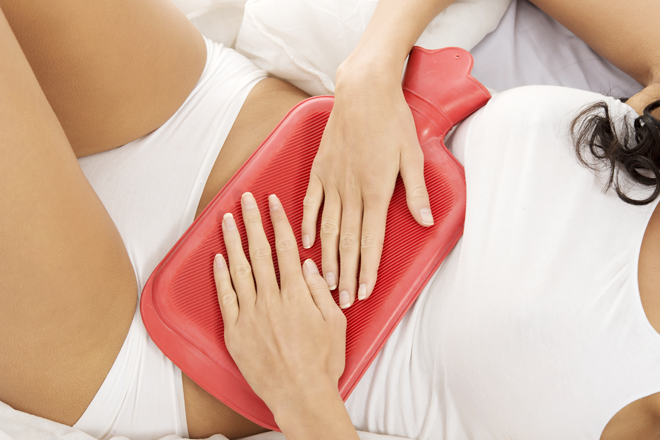
Pain and cramps, bloating, tiredness, and moodiness – you’ll recognise them as the all-too-familiar side effects of having your period. But don’t despair; there are easy and natural ways of making that one week a month a little more bearable. Take that, PMS!
Choose calcium-rich foods. Women need at least 1200 mg of calcium every day, particularly when menstruating. Foods rich in calcium (cabbage, broccoli, kale, spinach, turnips, yoghurt) will counteract muscle spasms and minimise cramps, and if you go for dark green vegetables like spinach, broccoli and kale they’ll help prevent excess bleeding as well by giving your body a good dose of vitamin K. You’ll find calcium in tomatoes too, higher levels of it when they’re stewed or tinned than when they’re fresh, and a glass of fresh orange juice is a good source as well.
Drink plenty water. Staying fully hydrated by drinking at least two litres of water a day will speed up your digestion and help ease the bloating caused by monthly hormonal changes.
Reduce salt and caffeine. Avoid processed and fast foods, with their high levels of salt, and you’ll help minimise bloating. Caffeine – found in tea, coffee and fizzy drinks – constricts blood vessels, raises tension, and irritates the stomach by increasing gastrointestinal acidity, all of which makes cramps worse. Stick to water and herbal teas instead. Add some ginger and honey and enjoy the natural anti-inflammatory properties.
Snack on dark chocolate. This is a fun one! Look for dark chocolate with at least sixty percent cacao, and eat a square a day to up your intake of antioxidants and stimulate your body’s production of serotonin, which counteracts irritation and mood swings.
Get moving. Exercise releases endorphins into your system, helping your body fight pain and enhancing positive feelings. You may not be energetic enough for your normal fitness routine, but walking, light jogging or stretching will increase the blood flow to your pelvic region and give relief from cramps. Swimming is another good option, helping to stretch abdominal muscles and stabilise blood flow. Or there are specific yoga poses aimed at relieving menstrual cramps, targeting the pelvis and lumbar region. Ask a yoga teacher for advice, or Google ‘yoga for cramps’ to find a wide range of exercises and instruction videos.
Bring on the heat. Stretch out and relax for a few minutes with a hot water bottle, ‘happy hugger’, or heating pad on your lower stomach. The warmth will loosen tight muscles and ease cramping, and the quiet time helps settle moodiness and irritability. Or take a hot bath – immersing yourself in hot water helps relieve all muscular (and emotional!) tension.
Take your vitamins. Vitamin E, found in avocado and egg yolk, helps balance mood swings, as does vitamin B6 which you’ll get from potatoes, bananas and oatmeal. B vitamins also ease bloating. Vitamin C and zinc support the all-round health of the reproductive system; you’ll find natural vitamin C in citrus fruits, and zinc in pumpkin seeds. Supplements such as magnesium, thiamine, and omega-3 may help reduce bloating, cramping and pain.
Some bloating or cramping just before, and during the beginning of, your period is perfectly normal, but check with your GP if you’re worried about what seems excessive bloating, heavy bleeding, or severe pain. Otherwise, don’t try to be superwoman – take it easy, eat wisely, exercise moderately, and lie back in a warm bath with some dark chocolate as often as you can! Some advice we can definitely co-sign.





6 Responses
I find that drinking a lot of water and doing light exercises helps during that time of the month to reduce the experience of pain.
My periods recently came back after 3 years of contraceptives, so I struggle during my periods. I don’t know what works for me so I take a pill and stay in bed all day. I don’t think exercising is such a good idea though, especially with a heavy flow.
This post says that calcium helps, but funny enough milk makes my cramps worse. Any idea why? Or is this just pertaining to calcium in foods?
Exercising does tend to get a little uncomfortable. I apply heat (this makes me nauseous at times) and take a very hot shower to ease the cramps. Eating clean helps too. Avoid JUNK FOOD it tends to make the cramps worse! Sip on a nice hot cup of tea and eat CLEAN.
A hot relaxing bath, ginger tea and Nurofen tablets are the best period pain reliever. Works for me
I find it very hard to get moving during that time of the month. Thank goodness I don’t experience pain or cramping but I feel bloated like a beached whale.